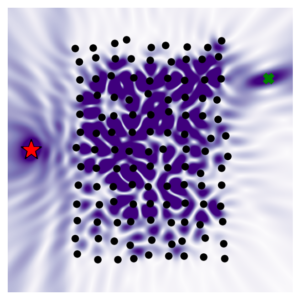
Congratulations to CMRI postdoctoral researcher James Capers who has had his work ‘Inverse Design of Thin-Plate Elastic Wave Devices‘ published in Physical Review Applied. In this work, James applies principles from electromagnetism to manipulate mechanical energy with a view towards using graded plates as lenses or for performing mode shaping. This work has applications for sensing, vibration control and energy harvesting.
On the publication, James says:
I’m very happy to share my latest paper, developing some methods for structuring elastic plates to manipulate how waves propagate on them. As well as demonstrating the usual adjoint method of inverse design to design graded plates, I also apply inverse design to multiple-scattering theory to determine how you should pin a plate to build an “invisibility cloak” for mechanical waves. These results are relevant to problems in energy harvesting, vibration isolation and sensing. Huge thanks to Prof. Simon Horsley and Dr. Greg Chaplain for their feedback on this work!
